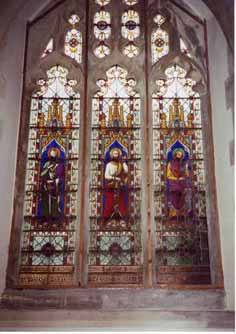| HARTGILL Chart 1600 |
![]()
| married | ||
|
1 WILLIAM HARTGILL born about 1493 of Culmington, (Kilmington) Somerset died/murdered 15th January 1556 Kilmington Somerset/Wiltshire |
 |
2 ??? |
| St Mary's Church Kilmington Somerset/Wiltshire stained-glass window dedicated to murdered men William and John HARTGILL |
||
| 3 Ann HARTGILL died 1585 Stepleton Dorest married John DACKOMBE |
4 Dorothy HARTGILL mentioned in the will of her sister Ann DACKOMBE née HARTGILL |
5 John HARTGILL died/murdered 15th January 1556 Kilmington Somerset/ married |
6 Thomas HARTGILL no details mentioned in fathers will |
7 Edward HARTGILL no details mentioned in fathers will |
|
![]()
If you have comments, alterations, corrections, amendments etc. please follow the details to be found on the Home Page to contact me.